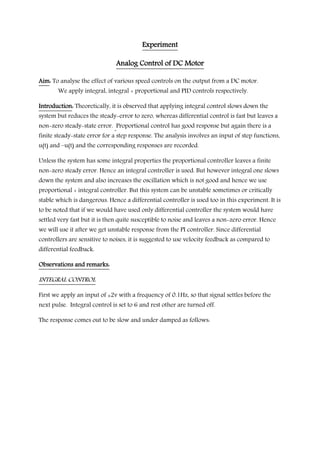
EEP301: Analog control of DC motor
- 1. Experiment Analog Control of DC Motor Aim: To analyse the effect of various speed controls on the output from a DC motor. We apply integral, integral + proportional and PID controls respectively. Introduction: Theoretically, it is observed that applying integral control slows down the system but reduces the steady-error to zero, whereas differential control is fast but leaves a non-zero steady-state error. Proportional control has good response but again there is a finite steady-state error for a step response. The analysis involves an input of step functions, u(t) and –u(t) and the corresponding responses are recorded. Unless the system has some integral properties the proportional controller leaves a finite non-zero steady error. Hence an integral controller is used. But however integral one slows down the system and also increases the oscillation which is not good and hence we use proportional + integral controller. But this system can be unstable sometimes or critically stable which is dangerous. Hence a differential controller is used too in this experiment. It is to be noted that if we would have used only differential controller the system would have settled very fast but it is then quite susceptible to noise and leaves a non-zero error. Hence we will use it after we get unstable response from the PI controller. Since differential controllers are sensitive to noises, it is suggested to use velocity feedback as compared to differential feedback. Observations and remarks: INTEGRAL CONTROL First we apply an input of ±2v with a frequency of 0.1Hz, so that signal settles before the next pulse. Integral control is set to 6 and rest other are turned off. The response comes out to be slow and under damped as follows:
- 2. Fig. 1 The response was not good so we took a zoom of the picture as below; it clearly shows the oscillations and settling For Ki=6 Tov= 720 ms Vov=1.12v Fig.2 Next Ki =12 was tried, which gave more oscillation though Tov decreased and Vov increased. However it is clear from the screen-shot that the settling time increased. For it observations were: Tov =560ms Vov=1.68v
- 3. Fig. 3 By reducing Ki to 1, we got following under damped response: Fig. 4 Conclusion: As we decrease Ki the response is under damped, but as Ki is increased the response time increases, it takes longer to settle. Also the overshoots increase which is not good for the system, so we want to decrease the overshoots and oscillation and hence a proportional control is introduced along with the integral. Response to Braking: We applied brakes setting Ki=6 and speed of 100 rev/min. The response for sudden application and release of brake was as follows, making input freq. almost zero:
- 4. Fig. 5 Fig. 6 For the ramp input at 0.1Hz, the output is as follows:
- 5. Fig. 7 PROPORTIONAL + INTEGRAL CONTROL We were supposed to keep Ki=12 and increase the proportional gain, starting from 0.1. Fig. 8 Tov=520ms Vov=1.48V Ki=12, Kp=.3 Fig. 9 Tov=560ms Vov=1.2V
- 6. Ki=12, Kp=.7 Fig. 10 Tov=520ms Vov=760mv Ki=12, Kp=1.2 Fig. 11 Tov=480ms Vov=400mv
- 7. Ki=12, Kp=3 Fig.12 Tov=440ms Vov=200mv Ki=12, Kp=6 Fig. 13 Conclusion: Oscillation decreases as the Kp is increased and hence response betters.
- 8. PROPORTIONAL + INTEGRAL + DERIVATIVE CONTROL The purpose of doing this was to demonstrate that integral controller can be unstable and hence we also need to incorporate differential controller. A square wave of ±.5V was applied at .2 Hz and with Kp=2 and Ki=1 the response was as follows: Fig. 14 Increasing Ki increases the oscillation and hence at Ki=8 or above the system becomes unstable. Fig. 15 for Ki=10
- 9. Even after removing the input we get the output i.e because system is at critical stability stage Fig. 16 To analyse the effect of a differential controller we set Ki=10 and Kp=11, the response is oscillatory with high amplitude Fig. 17
- 10. When we exert the load the response is Fig. 18 Now we switch on the differential controller with Kd=0.01, the response is not much different but as Kd is increased the oscillation decrease. Fig. 19
- 11. Kd=0.12 Fig. 20 Conclusion: Differential controller actually reduces the oscillation and integral controller ensures that the steady-state error is zero, however differential controllers are not used for the servo motor due to the reason they amplify the noises, velocity feedback is recommended
